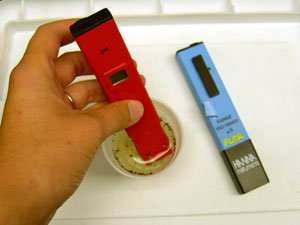Description
FACT SHEET:On-Site Testing of Growing Media & Irrigation WaterThis conversation occurs February 6th after the initial recommendations by the Extension Horticulturist are followed.Maria has completed a simple 1:2 media extraction (see page four of Floriculture Fact Sheet linked at right). She measured pH and EC with inexpensive hand-held meters that she calibrates prior to each use.
Results
Excerpts from a Phone Conversation February 6th
Maria:
Well, the pH was 6.32, which I thought was a little low, so I went ahead and applied the CaCO3 drench. However, the symptoms are just getting worse and worse, and now they are appearing on more plants.

Maria using a hand-held pH meter, note EC meter in the background. (photo courtesy of Marci Spaw)
Extension Horticulturist:
Did your EC check out as fine?
Maria:
Sure did. Readings were 0.36-0.4 mmhos/cm.
Extension Horticulturist:
How does the root system look?
Maria:
Fine. It’s plenty vigorous with mostly white roots; only older ones were kind of woody, so they were more brown. I really don’t think that there is any root rot problem.
Extension Horticulturist:
Is your insect scouting still turning up no pests but fungus gnats and shore flies?
Maria:
Right. That’s still the case.
Extension Horticulturist:
Are the affected plants still showing up in a random fashion?
Maria:
Yes. And the chlorosis is now a darker yellow color and has definite wavy bands towards the leaf edges. The younger leaves are even starting to look wrinkled and puckered. I’m getting concerned.
Extension Horticulturist:
This is a dilemma. Again, without seeing the plant it is hard for me interpret the symptoms, but several causes of the problem can now be ruled out…
[The Extension Horticulturist continues to outline the various causes of the problem that can be eliminated based on available information and suggest a course of action for Maria to follow.]



